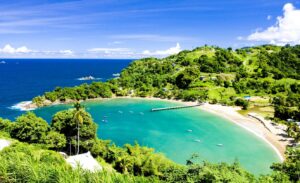Contents
Welcome to the enchanting world of Trinidad, a vibrant gem nestled in the heart of the Caribbean. Renowned for its rich cultural tapestry and breathtaking natural landscapes, Trinidad presents an underwater realm that is just as mesmerizing and diverse as its land. In this article, “Beneath the Waves: Coral Reefs and Marine Life of Trinidad,” we embark on a journey to explore the hidden treasures of Trinidad’s underwater ecosystems.
The coral reefs of Trinidad are more than just beautiful underwater structures; they are vital to the health and balance of marine biodiversity. These intricate ecosystems are bustling cities beneath the waves, hosting an astonishing variety of marine life. From tiny, colorful fish darting through the coral to the more elusive creatures that lurk in the depths, Trinidad’s reefs are a testament to the vibrant and complex web of life that thrives beneath the surface of the sea.
Our aim is to take you on a vivid exploration of these underwater wonders. We will delve into the intricate beauty and diversity of Trinidad’s coral formations, getting up close with the fascinating marine life that calls these reefs home. Through this journey, we hope to not only showcase the stunning beauty of these ecosystems but also to highlight their importance and the urgent need to protect them. Join us as we dive beneath the waves and discover the captivating coral reefs and marine life of Trinidad.
1: The Underwater Wonders of Trinidad
Trinidad, an island known for its vibrant culture and lush landscapes, is also home to some of the most spectacular underwater wonders in the Caribbean. The coral reefs surrounding Trinidad are not just visually stunning; they are ecological powerhouses, teeming with life and playing a crucial role in the marine ecosystem.
The Buccoo Reef, perhaps the most famous of Trinidad’s reefs, is a magnificent spectacle. Renowned for its crystal-clear waters and vibrant marine life, it is a haven for divers and snorkelers alike. This natural wonder showcases a kaleidoscope of coral species, from brain corals to elkhorn corals, creating a mosaic of colors and textures under the sea. The Buccoo Reef also features the Nylon Pool, an in-sea shallow white sand area, making it a unique attraction.
Another notable reef is the Culloden Reef, located off the coast of Tobago, a sister island to Trinidad. This reef is a quieter, less explored gem, offering a serene haven for both the coral and the myriad of species it supports. Here, the star corals and sea fans create an underwater landscape of breathtaking beauty and complexity.
These coral reefs are not just aesthetic marvels; they are vital for the ecological health of the Caribbean Sea. They provide shelter and breeding grounds for numerous marine species, some of which are unique to this region. The coral formations play a critical role in the life cycles of various fish species, many of which are important for the local fishing industry.
Incorporating keywords like “coral diversity in Trinidad,” this section highlights the reefs’ significance, both as natural wonders and ecological keystones. By exploring these underwater wonders, we gain a deeper appreciation for the intricate and beautiful world that lies beneath the waves in Trinidad.
2: Encountering Marine Life
As we continue our exploration beneath the waves of Trinidad, we encounter a diverse array of marine species, each playing its unique role in the ecosystem. The coral reefs of Trinidad are not just structures of beauty; they are thriving habitats for a myriad of marine creatures.
The reefs are bustling with a variety of fish species. Angelfish, with their vivid colors and graceful movements, glide through the coral formations. Parrotfish, easily recognizable by their bright patterns and parrot-like beaks, contribute significantly to the health of the coral by preventing algae overgrowth. The elusive moray eel, with its distinctive appearance, can often be spotted peeking out from its crevices.
One of the most majestic sights in these waters is the presence of sea turtles. The Hawksbill and Green turtles are often seen gracefully navigating through the reefs. These ancient mariners are not only a delight to behold but also play a crucial role in maintaining the health of the seagrass beds and coral reefs.
The reefs are also home to smaller, often overlooked creatures that add to the biodiversity of this underwater world. Colorful nudibranchs, a type of sea slug, are found in various forms and sizes, displaying a dazzling array of patterns. Tiny shrimp and crabs hide among the coral branches, while schools of shimmering silverfish dart through the water.
Local stories and legends often revolve around these creatures, adding a rich cultural dimension to the marine life of Trinidad. For instance, folklore tales speak of the mystical powers of sea turtles and their long-standing significance to the island’s indigenous communities.
Incorporating keywords such as “marine biodiversity in Trinidad” and “reef ecosystems,” this section not only showcases the variety of life found in these waters but also emphasizes the interconnectedness of these species. The stories and facts about local marine life serve to deepen our understanding and appreciation of these incredible creatures, reminding us of the wonder and fragility of life beneath the surface.
3: Conservation Challenges
The coral reefs and marine life of Trinidad, while resplendent, face significant challenges that threaten their survival. This section delves into the critical issues confronting these ecosystems and the concerted efforts required to safeguard them.
The Plight of Coral Reefs
- Climate Change: The most formidable challenge to coral reefs globally, including those in Trinidad, is climate change. Rising sea temperatures lead to coral bleaching, a phenomenon where corals lose their vibrant colors and essential life-supporting algae. This not only diminishes the reef’s aesthetic appeal but also its ability to support marine life.
- Pollution: From plastic waste to chemical runoff, pollution is a significant threat to the health of Trinidad’s coral reefs. Pollutants can smother coral, inhibit growth, and disrupt the delicate balance of the marine ecosystem.
Local and Global Efforts for Preservation
- Conservation Initiatives: Trinidad has implemented various conservation initiatives aimed at protecting its marine ecosystems. Marine protected areas (MPAs) have been established to restrict harmful activities and allow for the regeneration of marine life.
- Research and Monitoring: Continuous research and monitoring are crucial for understanding the health of the reefs and the impact of human activities. This data informs conservation strategies and helps in the development of more effective protection measures.
- Community Involvement: Engaging local communities in conservation efforts is vital. Educational programs and eco-tourism initiatives raise awareness about the importance of coral reefs and encourage sustainable practices.
Sustainability and Future Actions
- Sustainable Practices: Promoting sustainable fishing and tourism practices is essential to reduce the stress on coral reefs. This includes encouraging responsible diving and snorkeling practices and sustainable use of marine resources.
- Global Collaboration: The fight to save coral reefs is a global one. Trinidad’s efforts must be part of a larger international collaboration to address climate change and marine pollution.
Keywords for SEO: “coral reef conservation,” “marine sustainability in Trinidad,” “challenges to marine biodiversity,” and “climate change impact on coral reefs” are integral to this section. They not only emphasize the article’s focus on conservation and sustainability but also improve its search engine visibility for readers interested in environmental preservation.
This section aims to highlight the urgent need for action to protect these precious marine environments. By discussing the challenges and the steps being taken at both local and global levels, the article seeks to inspire a sense of responsibility and urgency among its readers.
“TRINIDAD TRAVEL GUIDE 2023”
‘TRINIDAD TRAVEL GUIDE 2023’ An e-book to explore Trinidad, offering comprehensive information on history, geography, culture, must-see attractions, gastronomy, outdoor adventures, accommodation, transportation, and local tips. From details about the vibrant Carnival to tips for diving and hiking, this guide is essential for anyone seeking a rich and authentic travel experience in Trinidad, highlighting the island’s cultural diversity and natural beauty.
Here’s the link for you to download the e-book.”
4: Experiencing the Subaquatic Beauty
The coral reefs of Trinidad offer a mesmerizing experience for both tourists and locals. However, it’s crucial that this exploration is conducted responsibly to ensure the sustainability of these fragile ecosystems. This section provides guidance on how to enjoy the underwater beauty of Trinidad while minimizing environmental impact.
Responsible Diving and Snorkeling
- Guided Tours: Opting for guided tours with environmentally responsible operators is a great way to explore the reefs. These guides are often well-informed about the safest and most sustainable practices.
- Eco-Friendly Practices: Tourists are encouraged to follow eco-friendly diving and snorkeling practices. This includes not touching or stepping on the coral, avoiding the use of harmful sunscreens, and not disturbing the marine life.
Sustainable Tourism in Trinidad
- Community Benefits: Sustainable tourism not only protects the reefs but also benefits the local community. By choosing local services, visitors contribute to the local economy and support conservation efforts indirectly.
- Educational Experiences: Many tours include educational components, teaching visitors about the importance of coral reefs and marine conservation. This knowledge helps in fostering a deeper appreciation and a sense of stewardship among tourists.
Promoting Conservation Through Tourism
- Conservation Partnerships: Some tour operators partner with conservation organizations. Portions of their proceeds go towards reef preservation efforts.
- Voluntourism Opportunities: For those who want to make a direct impact, there are opportunities to participate in conservation activities, like beach clean-ups or coral planting.
Keywords for SEO: Incorporating keywords such as “sustainable diving in Trinidad,” “responsible snorkeling,” and “ecotourism in the Caribbean” helps to attract readers interested in eco-friendly travel options. This also emphasizes the article’s focus on sustainable interaction with the underwater world.
By highlighting responsible ways to experience the subaquatic beauty of Trinidad, this section aims to inspire a sustainable approach to tourism. It underscores the idea that responsible tourism can significantly contribute to the conservation of these precious marine ecosystems, ensuring their beauty and biodiversity can be enjoyed by future generations.
Conclusion
As we conclude our journey beneath the waves of Trinidad, it’s clear that the coral reefs and marine life here are not just natural wonders but vital components of a delicate ecological balance. These underwater treasures, with their vibrant coral formations and diverse marine inhabitants, form the backbone of the marine ecosystem, supporting a myriad of life forms and contributing to the overall health of our oceans.
The coral reefs of Trinidad are more than just a source of natural beauty; they are guardians of biodiversity, protectors of coastal areas, and sustenance providers for both marine species and human communities. Their significance extends far beyond their immediate environment, influencing global marine health and the wellbeing of our planet.
However, these wondrous ecosystems face significant threats from factors like climate change, pollution, and unsustainable tourism practices. Their preservation is not just a local issue but a global imperative. Each one of us holds the power to make a difference, whether through our choices as tourists, our advocacy for environmental policies, or our daily actions to reduce our carbon footprint and protect our natural world.
This article calls for a collective effort towards conservation and conscious tourism. Let’s embrace sustainable practices that allow us to enjoy the beauty of the reefs while ensuring their longevity. As we stand in awe of the breathtaking coral reefs and the teeming life they support, let’s commit to being stewards of this irreplaceable resource.
In the radiant waters of Trinidad, the coral reefs whisper tales of resilience and beauty. They remind us of the intricate connections between all living things and the responsibility we hold to protect these connections. As we depart from these magical depths, let’s carry with us a renewed sense of purpose and a commitment to safeguarding the underwater marvels of Trinidad for generations to come.
Action
As we reach the end of our exploration of Trinidad’s captivating underwater world, we invite you to become an active part of this journey. If this article has inspired you, enlightened you, or sparked a desire to learn more, we encourage you to take the following steps:
Share and Engage
- Spread the Word: If you found value in learning about Trinidad’s coral reefs and marine life, please share this article with friends, family, and your social networks. Spreading awareness is a powerful tool in the conservation effort.
- Join the Conversation: We would love to hear your thoughts, experiences, and suggestions. Leave a comment below to engage in a meaningful discussion about marine conservation and sustainable tourism.
Explore and Learn
- Discover Trinidad’s Reefs Firsthand: Consider visiting Trinidad to experience its underwater beauty for yourself. Opt for guided tours that emphasize eco-friendly practices and support local conservation efforts.
- Participate in Educational Activities: Many local organizations in Trinidad offer educational programs and activities related to marine conservation. These can be incredibly enriching experiences for individuals, families, and groups interested in learning more about the importance of protecting our oceans.
Take Action
- Support Conservation Initiatives: Look for opportunities to support local and global conservation initiatives. Whether it’s through donations, volunteer work, or advocacy, every bit of effort counts.
- Practice Sustainable Tourism: Remember, as travelers and explorers, we have a responsibility to minimize our impact on the environments we visit. Choose sustainable options whenever possible and be a conscious and respectful visitor.
This call-to-action is not just about ending an article; it’s about starting a movement. Together, we can make a difference in preserving the stunning underwater world of Trinidad and ensuring that its beauty and biodiversity endure for future generations to enjoy. Let’s take these steps together towards a more sustainable and conscious future.



